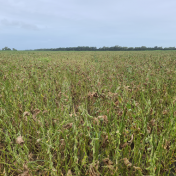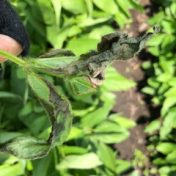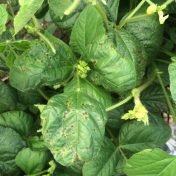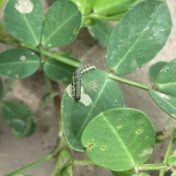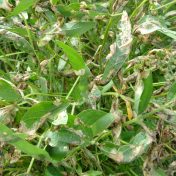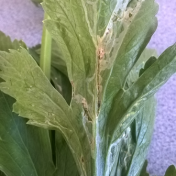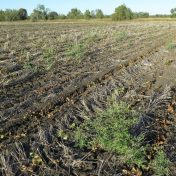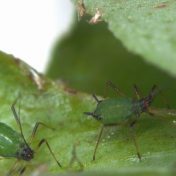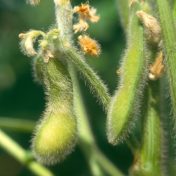Soybean moths are on the move in the tropics with devastating populations reported in the Ingham region of NQ (see photo). Fuelling the outbreaks was a recent extreme heatwave event which saw temperatures ranging between 29-40 degrees Celsius for 12 straight days. While the heat may have made people lethargic, it greatly hastened the rate of larval development and many… Read more »
Late damage has been reported recently in an Onyx-AU (PBR*) black gram crop in the Burdekin. The most obvious damage was dead leaves, but closer inspection found full sized larvae (3 mm) and pupae in the petioles of damaged leaves. The causal agent was common bean fly Ophiomyia phaseoli (Agromyzidae), but in this instance control was not warranted, as the… Read more »
Halo blight, caused by a bacterial pathogen (Pseudomonas savastanoi pv. phaseolicola) is one of the major diseases of beans world-wide, particularly in temperate regions. In mungbean, symptoms on leaves start as small, water-soaked lesions that are surrounded by a yellow-green halo (Figs 1 and 2). Symptoms may be visible at the 1st or 2nd trifoliate leaf stage and are often… Read more »
Since early 2020, growers and agronomists have been nervous about the prospect of fall armyworm (FAW; Spodoptera frugiperda) invading their crops. So far, the majority of significant and damaging FAW infestations have been recorded from sweet corn, maize, and sorghum crops, with some isolated outbreaks in horticultural crops such as ginger and capsicum. Occurrences in other crops have been a… Read more »
As we enter the business end of the season, we want our soybean crop’s leaves to be a healthy green, as the healthier the leaves, the more the pods fill and the higher the yield. In a drought year, dryland crops turn brown prematurely due to lack of water, but in wet years or in irrigated crops, leaves should not… Read more »
Another exotic leaf-mining fly, the serpentine leafminer (SLM; Liriomyza huidobrensis), also known as pea leafminer or South American leafminer, has recently been found in commercial vegetable crops (celery and green beans) in the Fassifern Valley (90 km south-west of Brisbane). This follows its previous detection in western Sydney in early November. The national plant pest and disease incursions technical committee… Read more »
Key points: There was a resurgence in tobacco streak virus (TSV) disease in mungbeans in early 2020 TSV is restricted to central QLD and closely related to the distribution of parthenium weed Growers are encouraged to avoid areas of dense parthenium to reduce risk In autumn of 2020, tobacco streak virus (TSV) was found to be common in all mungbean… Read more »
Faba bean aphid (FBA, Megoura crassicauda) was first noted in Australia on broad beans (Vicia faba L. cv. Coles Early Dwarf) in October 2016 in a Sydney suburb, (Hales et al., 2017). FBA was then recorded in September 2017 at two faba bean trial sites: NSW DPI Tamworth Agricultural Institute (TAI) and Liverpool Plains Field Station Breeza (LPFS Breeza). These… Read more »
As the summer cropping season winds down, there are some key observations in pulse crops made by leading consultants from New South Wales’s Northern Rivers and Queensland’s Hervey Bay regions that haven’t been covered in recent Beatsheet articles. 1: Indoxacarb failures linked to poor coverage The high Helicoverpa pressure encountered this summer resulted in many indoxacarb (e.g. Steward®) sprays being… Read more »
With a range of pest outbreaks recently (including fall armyworm), and the issuing of several new permits in Australia, there has been some confusion as to whether pulse crop references on spray labels and permits in Australia include soybeans. The good news is that the answer is yes it certainly does! Soybeans are listed by the APVMA under Crop Group… Read more »
